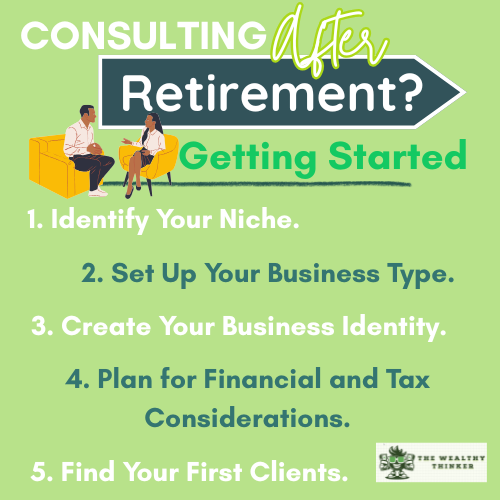Retirement doesn’t have to mean the end of your professional life.
For many, it marks the beginning of an exciting new chapter where decades of expertise can transform into a flexible, rewarding consulting business.
If you’ve spent years mastering your field, retirement presents the perfect opportunity to:
- share that knowledge on your own terms
- maintain intellectual stimulation
- generate additional income without the constraints of full-time employment
Let’s explore how to build a successful post-retirement consulting practice from the ground up, addressing everything from identifying your niche to handling the tax implications.

Consulting After Retirement: 9 Critical Steps to Get Started
1. Identifying Your Consulting Niche
The first step in establishing a consulting business is determining exactly what expertise you’ll offer.
While your career may have spanned multiple areas, successful consulting typically requires focusing on specific knowledge or skills where you truly excel.
Consider these popular post-retirement consulting categories:
Industry-Specific Expertise: If you’ve spent decades in manufacturing, healthcare, finance, or any specialized industry, companies will value your insider knowledge and perspective.
Functional Expertise: Perhaps your strength lies in specific business functions like human resources, supply chain management, financial planning, or marketing strategy.
Technical Knowledge: Engineers, IT professionals, scientists, and other technical specialists often find strong demand for their specialized knowledge.
Leadership and Management: Former executives can guide companies through transitions, mentor rising leaders, or help build effective teams.
Process Improvement: Experience optimizing operations or implementing methodologies like Six Sigma or Lean can translate into valuable consulting opportunities.
To narrow your focus, ask yourself:
- What problems did I consistently solve in my career?
- Which of my skills generated the most recognition and results?
- What aspects of my work did I most enjoy?
- Where do I have knowledge that’s still in demand and not easily found?
The sweet spot lies at the intersection of your expertise, market demand, and personal interest.
2. Setting Up Your Consulting Business
Once you’ve identified your niche, it’s time to establish the foundation of your business:
Business Structure Decisions.
The most common structures for consulting businesses include:
Sole Proprietorship: The simplest structure with minimal paperwork, but offers no personal liability protection.
Limited Liability Company (LLC): Provides personal asset protection while maintaining tax simplicity.
S Corporation: May offer tax advantages for higher-earning consultants by potentially reducing self-employment taxes.
While many retirees start with sole proprietorships for simplicity, consulting even part-time makes liability protection worth considering.
Consult with a business attorney or accountant to determine the best structure for your situation.
3. Creating Your Business Identity
Develop a clear, professional presence:
Business Name: Choose something memorable that reflects your expertise.
Professional Email: Create a dedicated business email address.
Website: Even a simple site adds credibility and helps clients find you.
Business Cards: Still valuable for in-person networking.
LinkedIn Profile: Update to reflect your consulting focus rather than job-seeking status.
Keep your business identity simple but professional. Your decades of experience are your primary selling point – no need for flashy branding or elaborate marketing materials.
4. Financial and Tax Considerations
Consulting income can significantly impact your retirement finances, particularly regarding taxes and retirement benefits.
Tax Implications
Consulting income during retirement creates several tax considerations:
Self-Employment Taxes: You’ll owe both the employer and employee portions of Social Security and Medicare taxes (15.3% total) on your consulting income.
Quarterly Estimated Taxes: You’ll likely need to make quarterly tax payments to avoid penalties.
Deductions: Tracking business expenses becomes crucial, as these can significantly reduce your taxable income. Common deductions include:
- Home office expenses
- Travel and mileage
- Professional subscriptions and education
- Equipment and supplies
- Professional services (accounting, legal)
- Health insurance premiums
Social Security Benefits: Additional income may make a portion of your Social Security benefits taxable.
If your combined income (adjusted gross income + nontaxable interest + half of Social Security benefits) exceeds certain thresholds, up to 85% of your benefits may become taxable.
Medicare Premiums: Higher income from consulting could increase your Medicare Part B and Part D premiums through Income-Related Monthly Adjustment Amounts (IRMAA).
Required Minimum Distributions (RMDs): Remember that once you reach 73, you must take RMDs from traditional retirement accounts, which contribute to your overall tax picture alongside consulting income.
Working with a tax professional familiar with self-employment and retirement income is highly recommended, as the interaction between consulting income and retirement benefits can be complex.
5. Finding Your First Clients
The thought of finding clients often intimidates new consultants, but retirees have a significant advantage: decades of professional relationships.
Here’s how to leverage those connections and beyond:
Start With Your Network
Your most valuable asset is your existing professional network:
Former Employers: Companies familiar with your work may welcome your expertise in a consulting capacity, especially if your departure left knowledge gaps.
Industry Colleagues: Let your professional contacts know you’re available for consulting. They may need your services or refer you to others who do.
Professional Associations: Remain active in industry groups where your expertise is valued.
Personal outreach works best here – individualized emails or phone calls rather than mass announcements. Explain your new consulting focus and how you might help them or their contacts.
Expand Your Reach
As you exhaust your immediate network, broaden your approach:
LinkedIn: Optimize your profile for consulting, publish relevant content, and engage with industry discussions.
Speaking Engagements: Offer to speak at industry events or webinars to demonstrate your expertise.
Writing: Contribute articles to industry publications or maintain a blog showcasing your knowledge.
Partnerships: Connect with complementary consultants or small firms that might bring you in for specialized projects.
6. Proposal and Pricing Strategies
Setting your rates can be challenging for new consultants.
Research your industry’s standards but remember that your extensive experience likely commands premium rates. Consider these common structures:
Hourly Rates: Typically range from $75-$300+ depending on your field and expertise.
Project-Based Fees: Fixed prices for defined deliverables.
Retainer Arrangements: Monthly fees for ongoing availability and services.
Value-Based Pricing: Fees based on the value delivered rather than time spent.
When preparing proposals, focus on specific outcomes and benefits rather than just activities. Clearly outline deliverables, timelines, and fee structures to avoid misunderstandings.
7. Managing Your Consulting Practice
Balancing a consulting business with retirement requires thoughtful time management and boundary setting.
Setting Boundaries
One of retirement’s primary benefits is freedom and flexibility – don’t surrender this entirely to your consulting practice:
Capacity Limits: Decide upfront how many hours or projects you’ll accept monthly.
Availability Hours: Establish clear working hours and stick to them.
Vacation Blocks: Block out personal time and travel periods where you won’t be available.
Project Selection: Be selective about which projects you accept, focusing on those that are most interesting or lucrative.
Practical Operations
Streamline your practice with efficient systems:
Project Management: Use simple tools like Trello or Asana to track deliverables and deadlines.
Time Tracking: Apps like Toggl or Harvest help monitor hours for billing purposes.
Accounting Software: QuickBooks Self-Employed or FreshBooks simplify expense tracking and invoicing.
Contract Templates: Develop standard agreements to streamline onboarding new clients.
Virtual Assistance: Consider hiring part-time virtual support for administrative tasks.
The goal is to maximize your billable time while minimizing administrative burden.
8. Growing Your Practice
As your consulting business matures, consider these growth strategies:
Specialization: Further narrow your focus to become the go-to expert in a specific niche.
Premium Offerings: Create high-value service packages commanding higher fees.
Digital Products: Develop courses, guides, or templates that generate passive income.
Strategic Alliances: Partner with other consultants to tackle larger projects.
Selective Delegation: Bring in subcontractors for tasks outside your core expertise.
Growth doesn’t necessarily mean working more hours – it means increasing your impact and income within your desired schedule.
9. Balancing Work and Retirement
Remember that consulting should enhance your retirement, not consume it. Regularly assess whether your practice aligns with your broader life goals:
Regular Reviews: Schedule quarterly reviews of your workload and satisfaction.
Adjustment Periods: Be willing to scale back during times when other priorities take precedence.
Success Metrics: Define success beyond income – consider fulfillment, impact, and work-life balance.
Exit Strategy: Have a plan for eventually winding down your practice when you’re ready for full retirement.
Consulting After Retirement: The Bottom Line
Consulting after retirement offers a powerful way to remain engaged professionally while enjoying the freedom retirement provides.
The expertise you’ve spent decades building has significant value, and consulting allows you to share that value on your own terms.
Start small, focusing on your network and core expertise.
Be intentional about the practice you build, ensuring it enhances rather than detracts from your retirement lifestyle.
With thoughtful planning and clear boundaries, post-retirement consulting can provide intellectual stimulation, social connection, and financial benefits for years to come.
Remember that the perfect consulting practice isn’t the largest or most lucrative – it’s the one that brings you satisfaction while complementing the retirement lifestyle you’ve earned.



















